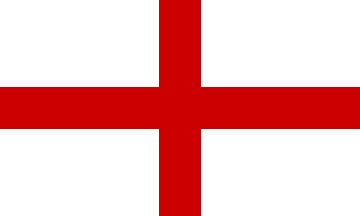
Last modified: 2007-07-28 by rob raeside
Keywords: anglican church | episcopal church | church of england | st. george cross |
Links: FOTW homepage |
search |
disclaimer and copyright |
write us |
mirrors
 by
Vincent Morley
by
Vincent MorleyOn this page:
See also:
Church of England churches fly the defaced St. George's cross. Cathedrals tend to
fly a banner of arms of the diocese. The Archbishop of Canterbury (Protestant Metropolitan) and the Cardinal Archbishop of Westminster
(Catholic Metropolitan) both have flags for their office which are almost identical apart from the background
colour.
Graham Bartram, 18 January 2002
Can a church fly any flag it wishes at any time?
[Answer:] The Earl Marshall's warrant of 9 February 1938 reads:
'Whereas the Most Reverend Cosmo Gordon, Archbishop of Canterbury, ...hath
represented unto me that uncertainty exists as to the flags proper to be flown
upon Churches, in consequence whereof there is diversity of practice, and for
the avoidance thereof has requested me to make such a general order as may be
proper ...[I] hereby ordain and declare the Banner or Flag proper to be flown
upon any Church within the Provinces of Canterbury and York to be the Cross of
St. George and in the first quarter an escutcheon of the Arms of the See in which
such Church is ecclesiastically situated.'
Numerous churches also have special warrants to fly other flags. I have a letter
from Westminster Abbey, dated 9 March 1939, asserting its right to fly the Royal
Standard, a heraldic banner of its arms, and a crossed-keys flag. Certain
churches have the right to fly the white ensign, including St.
Martin-in-the-Fields, London, and All Saints', Burnham Thorpe (which uses the
1707 version). But tradition also seems to be important. It would be a brave
soul who tried to eradicate the plain St. George's flag from our towers.
André Coutanche, 4 November 2004
The website at
www.cofe.anglican.org shows locations of dioceses of the Church of England,
and heraldry of the dioceses.
Ned Smith, 6 November 2004
The question of the correct flag to fly from a flag staff on an English church was raised in February 1907, when Sir A. Scott-Gatty, Garter King of Arms, wrote that, "churches should not fly the national flag. It should be the cross of St. George impaling the arms of the See (arms in the hoist and cross in the fly ?), but until the sovereign has spoken on this matter by a Royal Warrant, there is no flag that can be flown with propriety." [HO 45/10287/109071]
The matter came up again after the coronation of George VI when according to a letter published in The Times newspaper on 18 January 1938; "Herald's College referred to this in 1911 at Coronation of George V. Cross of St George impaled with the arms of the diocese is the flag." A note in the file added that the flag did not exist and that the plain St. George's Flag was correct. [HO 144/22962]
Later in 1938 the Earl Marshall issued a warrant declaring the proper flag on
churches to be St George's cross with the arms of the See in the canton.
Some English churches fly, or have flown, the White Ensign of the Royal Navy.
Details in a separate page.
David Prothero, 17 January 2002
RULES GOVERNING THE FLYING OF CHURCH FLAGS
By a warrant dated 9th February 1938 the Earl Marshal laid down that the flag to
be flown upon any church within the Provinces of Canterbury and York was "The
Cross of St George and in the first quarter the escutcheon of the Arms of the
See in which the church is ecclesiastically situated". In simple words, the flag
of St George with the diocesan arms in the top corner nearest to the mast.
Questions have been asked about certain details and the Garter Principal King of
Arms gave the following directions:-
On the subject of C of E flags, and when (or why) some churches fly flags with
the arms of the diocese in the corner, while others do not, I asked the Revd
John Hall, who is Chairman of the Flag Institute, as well as a clergyman. He
told me that the decision was the responsibility of the Parochial Church
Council. Often, the cost of the flag with the arms in the canton is too much,
and so they opt for the cheaper plain St. George's flag. However, if it becomes
a particular hobby horse of a PCC member, then sometimes the money can be found.
Ian Sumner, 10 May 2006